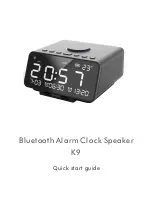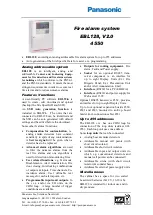
Owner’s Instructions
Fire Safety In The Home
Most fires occur in the home, and to minimize this danger, it is rec-
ommended that a household fire safety audit be conducted and a
family escape plan be developed.
Household Fire Safety Audit
1. Are all electrical appliances and outlets in safe condition?
Check for frayed cords, overloaded lighting circuits, etc. If you
are uncertain about the condition of your electrical appliances
or household service, have a professional evaluation.
2.Are all flammable liquids safely stored in closed containers,
and in a cool and well ventilated area? Cleaning the unit with
flammable liquids should be avoided.
3.Are hazardous materials (i.e., matches) out of the reach of
children?
4.Are furnaces and wood burning appliances properly installed,
clean, and in good working order? If in doubt, have a profes-
sional evaluation.
Family Escape Planning
There is often very little time between the detection of a fire and the
time it becomes deadly. Because of this, it is very important that a
family escape plan be developed and rehearsed.
• Every family member should participate in the escape plan.
• Study the possible escape routes from each location within the
house. Since many fires occur at night, special attention should be
given to the escape routes from sleeping quarters.
• It is essential that escape from a bedroom be possible without
opening the interior door. Consider the following when making
your escape plans:
• Ensure that doors and windows that open to the outside are eas-
ily opened. Ensure that they are not painted shut and that the
locking mechanisms operate smoothly.
• If opening or using the exit is too difficult for children, the elderly
or handicapped, plans for their rescue should be developed. This
plan includes making sure that those who are to perform the res-
cue can promptly hear the fire warning signal.
• If the exit is above the ground level, an approved fire ladder or
rope should be provided, as well as training in its use.
• Exits on the ground level should be kept clear. Be sure to remove
snow from exterior patio doors in the winter and that outdoor
furniture or equipment does not block exits.
• The family should have a predetermined assembly point where
everyone can be accounted for; for example, across the street or
at a neighbor’s house.
• Once everyone is out of the house, call the Fire Department.
• A good plan emphasizes a quick escape. Do not investigate first
or attempt to fight the fire, and do not attempt to rescue belong-
ings or valuables as this takes up time. Once outside, do not re-
enter the house; wait for the Fire Department.
• Write the plan down and rehearse it frequently so that should an
emergency ever arise, everyone will know what to do. Revise the
plan as conditions change; for example, when there are more or
fewer family members in the home or if there are changes to the
house.
• Make sure your fire warning system is operational by conducting
weekly tests. If you are unsure about system operation, contact
your smoke detector installer or dealer.
• DSC recommends that you contact your local Fire Department
and request further information on home fire safety and escape
planning. If available, have your local fire prevention officer con-
duct an in-house fire safety inspection.
Testing Your Smoke Detector
Follow the test procedure described here or contact your smoke
detector dealer or installer for testing instructions. DSC
recommends that you test the entire alarm system at least once
a week to verify the operation of all system functions.
Smoke Detector Unit Test
Initiate test by pressing the test button for 5 seconds (min.), the
sounder makes clicking noises during this time. Press the button
until the unit alarm sounds; an alarm should be sent to the control
panel. When the button is released, the alarm should cease. If this
does not occur, ensure batteries are the correct type, in good condi-
tion and are installed correctly (see
3. Install Batteries
in the
Installation Instructions
section).
Upon completing the functional testing of the smoke detector,
check the unit’s sensing chamber to ensure proper operation. To
test the sensing chamber, wave a lit cotton wick or punk stick
around the outside of the unit until a generous amount of smoke
enters the sensing chamber or the unit alarms. If the smoke detec-
tor does not function properly, call your smoke detector installer or
dealer for service.
Owner’s Maintenance
The smoke detector is designed to require minimum maintenance.
If the case becomes dusty, vacuum with a small brush attachment.
If the case is greasy, wipe the case gently with a soft cloth slightly
dampened with soapy water.
Never disassemble the smoke detector; there are no user
serviceable parts inside the unit. You may only remove detector
from backplate to replace batteries if not serviced by installer.
When replacing the batteries, follow the instructions specified
within the Installation Instructions, Item 3 Install Batteries.
CAUTION: This product uses lithium batteries, improper
handling may result in a HEAT, EXPLOSION or FIRE causing
personal injury. DO NOT recharge batteries. Follow the battery
manufacturer’s safety instructions. Dispose of used batteries in
accordance with the regulations in your area.
Never paint the unit. Paint may prevent smoke from entering
the unit. If you are planning renovations or repainting, contact
your installer and ask that the unit be temporarily removed until
work is complete.
If the unit is located in an area where it is exposed to high levels of
dust or insects and causes false alarms, it may require service; con-
tact your smoke detector installer or dealer.
Testing and maintenance procedures shall be in accordance with
CAN/ULC-S552-02.
Specifications
• Diameter (base): 5.8in (147mm)
• Height (including base): 2.077in (52.8mm)
• Alarm Sensitivity (threshold) UL: 3.0±0.8%/ft obscuration, ULC:
2.0±0.5%/ft obscuration, EU: complies with EN54-7/A2
• Alarm Silencing (ULC Model): 8 minutes automatically resettable
• Warning threshold: 75% of alarm threshold for 120 seconds
• Supervisory Transmission Frequency UL, ULC: 64 min. intervals
• Supervisory Transmission Frequency EU: 12 min. intervals
• Sounder Alarm Pattern UL, ULC, EU: evacuation temporal pattern
• Operating Temperature: 32º-100ºF (0º-37.8ºC)
• Humidity: 5%-95% RH, non-condensing
• Batteries (2) CR123A
• Low Battery Detection: Low battery 14 days remaining
• Approved Batteries: Panasonic CR123A, Sanyo CR123A and
Duracell DL123A
Alarm Indications
*ULC models only
This product has been approved by the California State Fire
Marshal (CSFM) pursuant to section 13144.1 of the California
Health and Safety Code. See CSFM Listing No. 7272-1273:125
for allowable values and/or conditions for use concerning mate-
rial presented in this document. The approval is subject to reex-
amination, revision and possible cancellation.
The smoke alarm WS4926 has a recommended service life of
10 years under normal conditions of use. Please refer to the
label applied to the device indicating the recommended
replacement year.
For servicing the unit or replacement batteries please call your
installation company that provided you with the alarm system.
Condition
LED
Sounder
Transmission
Normal
Flash 1/50s
OFF
Supervisory
Alarm Smoke
Flash 1/1s
Temporal
or
Steady
Alarm
Early Warning
Smoke
Flash 1/50s
CHIRP
None
Compensation
Trouble High
OFF
CHIRP
Trouble
Compensation
Trouble Low
OFF
CHIRP
Trouble
Sensor/
Internal Fault
OFF
CHIRP
Trouble
Low Battery
0 - 7 days
Flash 1/50s
OFF
Low Battery
Low Battery
0 - 7 days & Test or
Alarm
Flash 1/50s
CHIRP
Low Battery
Low Battery After
7 days
Flash 1/50s
CHIRP
Low Battery
Tamper
Flash 1/50s
OFF
Tamper
Alarm Silencing *
Flash 1/8s
OFF
Alarm Restoral


























